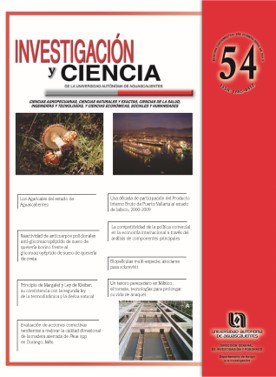Margalef Principle and Kleiber Law: its consistency with the second law of thermodynamics, and the natural drift
DOI:
https://doi.org/10.33064/iycuaa2012544072Keywords:
basal metabolic rate, weight, self organizationAbstract
The study of the relationship between basal metabolic rate and mass developed by living things, shows that the total mass of bodies increases more what metabolic capacity decreases over time. Living beings would then be increasingly efficient to generate structure, with the increasingly meager energy dissipated per mass unit. Increasing efficiency in the management of information and energy is remarkable in living organisms with the passage of time.
Downloads
References
• DAWKINS, R., El cuento del antepasado. España: Ed. Antoni Bosch, 2004.
• FLOS, J., El concepto de información en la ecología margalefiana. Ecosistemas, 14(1): 7-17, 2005.
• HEMMINGSEN, A., Energy metabolism as related to body size and respiratory surfaces, and its evolution. Reports of the Steno Memorial Hospital, 4: 1 -110, 1960.
• KLEIBER, M., Body size and metabolic rate. Physiological Reviews 27 (4): 511-541, 1947. DOI: https://doi.org/10.1152/physrev.1947.27.4.511
• KOZLOWSKI, J.; KONARZEWSKI, M., Is West, Brown and Enquist’s model of allometric scaling mathematically correct and biologically relevant? Functional Ecology, 18: 283–9, 2004. DOI: https://doi.org/10.1111/j.0269-8463.2004.00830.x
• KOZLOWSKI, J.; KONARZEWSKI, M., West, Brown and Enquist’s model of allometric scaling again: the same questions remain. Functional Ecology, 19: 739-743, 2005. DOI: https://doi.org/10.1111/j.1365-2435.2005.01021.x
• MATURANA, H.; VARELA, F., De máquinas y seres vivos. Argentina: Ed. Lumen, 2003.
• McDONALD, P.; EDWARDS, R.; GREENHALGH, J.; Morgan C., Nutrición animal. España: Ed. Acribia, 2006.
• MORGADO, E.; GÜNTHER, B.; COCIÑA, M.,Relaciones entre el metabolismo oxidativo y la obesidad. Parte 1. Revista chilena de ciencia y clínica, 3: 43-52, 2006.
• SCHMIDT-NIELSEN, K., Scaling: why is animal size so important? Gran Bretaña: Cambridge University Press, 1984. DOI: https://doi.org/10.1017/CBO9781139167826
• WEST, G.; ENQUIST, B.; BROWN, J., The fourth dimension of life: fractal geometry and allometric scaling of organisms. Science, 284: 1677-1679, 1999. DOI: https://doi.org/10.1126/science.284.5420.1677
• WANG, Z.; O’CONNOR, T.; HESHKA, S.; HEYMSFIELD, Nutritional Methodology: The Reconstruction of Kleiber’s Law at the Organ Tissue Level. The Journal of nutrition, 131(11): 2967-70, 2001. Dictiotopografía DOI: https://doi.org/10.1093/jn/131.11.2967
• DE COSTA J.; ROL DE LAMA, M., Estudio de la tasa metabólica de los mamíferos: efectos del tamaño corporal y de la temperatura ambiental. Universidad de Murcia. España. Facultad de Biología. Departamento de Fisiología. 2009. Disponible en http://www.um.es/
fisfar/Alometrafo.pdf.
• Gerber, W., Física en las Ciencias Forestales. Leyes Universales. Teoría. Instituto de Física, Universidad Austral, Valdivia, Chile 12.10. 2009. Disponible en: http://downloads.gphysics.net/UACH/Forestal/UACH-Fisicaen-las-Ciencias-Forestales-2-5-Leyes-Universales-Teoria.pdf.
• MORGADO, E.; GÜNTHER, B.; COCIÑA, M., Rango homeostático del metabolismo oxidativo: 60 años de fisiometría integrativa. Revista médica de Chile. v.133 n.3. Versión impresa ISSN 0034-9887. 2005. Disponible en: DOI: https://doi.org/10.4067/S0034-98872005000300013
http://www.scielo.cl/scielo.php?script=sci_arttext&pid=S0034-98872005000300013.
• SÁNCHEZ, S.; BARRAGÁN, J., Evolución del peso y el metabolismo basal en varones: su relación con el principio de Margalef: Análisis de tablas. Aleph Zero, núm. 58. México. 2010. Disponible en: http://hosting.udlap.mx/profesores/miguela.mendez/alephzero/index.html.
• SÁNCHEZ, S.; BARRAGÁN, J., El peso metabólicamente activo: entre la ley de Kleiber y la segunda ley de la termodinámica. Revista Argentina de Endocrinología y Metabolismo, 48(3): 136-142, 2011. Disponible en:
www.raem.org.ar/numeros/2011/3/136-142Endo3-Barragan.pdf.
Downloads
Published
How to Cite
License
Copyright (c) 2012 Jorge Barragán, Sebastián Sánchez

This work is licensed under a Creative Commons Attribution-NonCommercial-ShareAlike 4.0 International License.
Las obras publicadas en versión electrónica de la revista están bajo la licencia Creative Commons Atribución-NoComercial-CompartirIgual 4.0 Internacional (CC BY-NC-SA 4.0)









